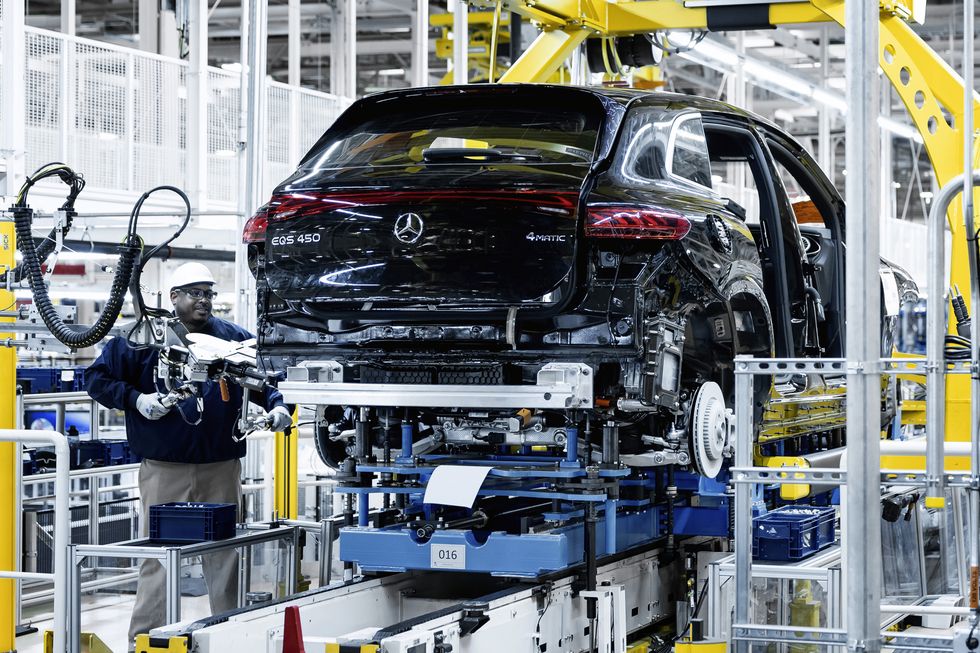Gas and Electric Models Sometimes Look the Same—Until You Look Inside

From the June 2023 issue of Car and Driver.
When Maserati unveiled its handsome second-generation GranTurismo coupe, our initial response was a bit muted, even muddled. “Is that new?” we asked of the lovely but familiar design. This sense of confoundment grew when we discovered that the automaker would offer this exact vehicle—a long-hood, short-deck GT with a conventional profile—in two disparate powertrain configurations. Buyers can tour grandly in a coupe with a twin-turbo V-6 internal-combustion engine or in a battery-electric vehicle, but you might not guess from the outside that the insides are different.
Maserati design head Klaus Busse says a desire to maintain the traditional design and dynamic sensibilities for which the trident brand is known dictated this move. “We can keep the low silhouette of the car because we’re not putting anything under the front seats,” he says of the decision regarding placement of electric components. Unlike many competitors that incorporate a height-raising battery pack in the floor, Maserati’s uniquely shaped pack occupies the engine compartment, the transmission tunnel, and some space behind the rear seats.
The arrangement isn’t just for aesthetics. “When you have the batteries underneath the seats all the way outboard, then the car tends to understeer because you have all these gravitational forces of the batteries,” Busse says. “By keeping the batteries central, you avoid these gravitational forces, and you avoid understeer.”
Assembly lines are in a time of flux. The future looks electric, but companies are easing the transition by building both internal-combustion machines and EVs.
BMW
Though the brand plans to go all-electric by 2030 and will eventually introduce BEV-only designs, the dual powertrain offerings will continue through this decade. Maserati will electrify its Grecale SUV in the same fashion.
Multiple Powertrains, One Vehicle
Maserati isn’t alone in this strategy. After introducing the wildly styled i3 for 2014 and seemingly planning a rollout of separate electric vehicles from its i subbrand, BMW has shifted course. While it still reserves the right to release the occasional one-off dedicated battery-electric model, like the radically styled and bedazzled iX, its core plan is to continue to create vehicles—such as the 4-series Gran Coupe and the 7-series luxury sedan [see “Green Is Good,” page 48]—that can accommodate a battery-electric, a plug-in-hybrid, or an internal-combustion powertrain.
“The transformation to electrification, we believe, doesn’t go from one day to the other,” says Domagoj Dukec, BMW’s head of design. The brand wants to be sure customers are satisfied with both ICE and BEV offerings, he adds.
“For us, the one promise is that BMW driving character will always be highly dynamic,” Dukec says. “It doesn’t matter if it’s diesel or gas; it doesn’t matter if it’s a plug-in hybrid—it will be dynamic. And if it’s electric, it will also be dynamic.” This flexible strategy allows BMW to respond to shifting market needs and regulations by producing more or fewer of any powertrain according to demand. “The winner will probably be the one who can adapt to this unpredictability,” he says.

Mercedes-Benz
Land Rover seems to be following a similar path. When it revealed the current-gen Range Rover for 2022, the company announced that this luxurious off-roader—along with five other members of the Land Rover family—would be offered with a traditional combustion engine, as a plug-in hybrid, or with an EV powertrain, though not all the electrified options have appeared in the U.S. yet.
Automakers Making Full Shift to Electric
Land Rover stablemate Jaguar, an early adopter of BEV technology with the 2019 I-Pace, is taking a different tack. It plans to transition to a fully electric lineup this decade, introducing a range of all-new electric products, beginning with upscale SUVs.
Volvo, too, is going all in. The brand has ceased development of new internal-combustion powertrains and is committed to full electrification by 2030, replacing its existing models with battery-electric versions. This process begins with the electric 2024 EX90, which will eventually replace the XC90. “Volvo has never been a manufacturer known predominantly for engines,” says Owen Ready, the company’s head of strategic and brand design. “This positions us well for this transition.”
Perhaps more surprising, Cadillac is also taking this route. It announced that the recently revised Escalade is its last ICE vehicle line—and has just revealed the EV successor, the 2025 Escalade IQ. Moving forward, all future Caddys will be electric, like the just-released Lyriq SUV and Celestiq flagship sedan.

Volvo
Mercedes Following Separate Paths
Luxury juggernaut Mercedes is taking a different road during this transitional decade—or rather, two roads. Alongside its extensive range of ICE models, Benz is developing a full lineup of parallel BEVs. The S-class and E-class sedans have electric doppelgängers in the EQS and EQE sedans, but those are built on their own platform. “Purpose architecture deserves a purpose,” says Robert Lesnik, the brand’s head of exterior design, speaking of the differentiation between the traditional three-box configuration of Benz’s traditional cars and the arcing bow shape of its electric ones. “That means from the outside, you’re able to see that this is not just a conventional or known car.”
Mass-market brands such as Honda and Kia are following a similar tactic. Honda plans for its electrified mid-size Prologue SUV and small affordable EVs (all jointly developed with GM) to coexist with the Pilot and Civic. Kia introduced the electric two-row EV6 and three-row EV9 alongside the similar Seltos and Telluride. Both brands may continue producing vehicles with tailpipes beyond 2030.
For Mercedes, the parallel track will last only through the 2020s, or one vehicle generation, after which the brand plans to shift to an entirely electric lineup. “Like a zipper on your jacket. When you open it up, the two sides spread,” Lesnik explains. “And by the end of the decade—the life cycle of one car—everything will be electric, and the zipper comes together again.”

Contributing Editor
Brett Berk (he/him) is a former preschool teacher and early childhood center director who spent a decade as a youth and family researcher and now covers the topics of kids and the auto industry for publications including CNN, the New York Times, Popular Mechanics and more. He has published a parenting book, The Gay Uncle’s Guide to Parenting, and since 2008 has driven and reviewed thousands of cars for Car and Driver and Road & Track, where he is contributing editor. He has also written for Architectural Digest, Billboard, ELLE Decor, Esquire, GQ, Travel + Leisure and Vanity Fair.







